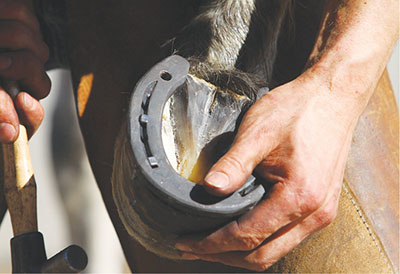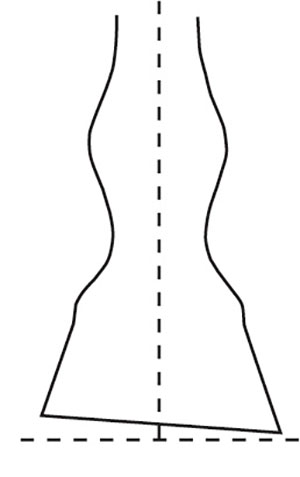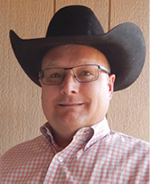Guide B-707
Revised by Jason L. Turner
College of Agricultural, Consumer and Environmental Sciences, New Mexico State University
Author: Professor/Extension Horse Specialist, Department of Extension Animal Sciences and Natural Resources, New Mexico State University. (Print Friendly PDF)
© Maria Ltina | Dreamstime.com
The objective of this guide is to provide horse owners with basic information to evaluate their current hoof care practices. This guide provides reference information on standard hoof care for horses with “normal” hoof structure. However, it is not intended as a substitute for advice from a professional farrier or veterinarian.
Proper hoof care is an important aspect of equine management that is often overlooked. Proper hoof care encompasses more than regular trimming and shoeing. Providing adequate nutrition, a healthy environment free of debris (such as manure), regular cleaning of feet to remove compacted manure, and treatment of any injury or disease of the foot are all key components of hoof care.
The primary functions of the equine foot are to bear weight, absorb shock, and provide traction. Improper hoof care reduces the ability of the foot to perform these functions and increases the amount of stress applied to the joints, tendons, and ligaments of the equine limb. The various parts of the equine foot that will be discussed in this guide are shown in Figure 1.
Figure 1. Parts of the equine hoof. (Baskins, 1997. Used with permission.)
Horses are trimmed and shod to maintain the balance and integrity of their hooves. The average hoof grows 3/8 of an inch per month; therefore, most horses should be trimmed or shod every 6 to 12 weeks. However, hoof wall growth varies with climate and between individual horses, and the trimming or shoeing interval should be adjusted accordingly.
Under most circumstances, trimming on a regular basis is sufficient for maintaining healthy feet; however, when wear exceeds new hoof growth, horses should be shod. Horses are also shod to enhance performance or as therapeutic treatment for various diseases and conditions.
Trimming
In the process of trimming, excess hoof wall is removed to restore the balance and integrity of the hoof. Sufficient wall and sole should be left intact to prevent the horse from becoming excessively sore following trimming. Trimming should be evaluated on the basis of levelness, balance, proper alignment of the hoof-pastern axis, and symmetry.
Levelness
The hoof should be trimmed so that the groundbearing surface of the foot is flat (Figure 2). The hoof wall should be slightly higher than the sole, so that the hoof wall bears a majority of the horse’s weight. The bars of the foot should gradually taper upward from the sole to the heels. The bars should be slightly higher than the sole and lower than the wall. The frog should not be excessively pared and should be trimmed in a manner that opens up the commissures of the foot (the grooves that separate the frog from the bars of the hoof). Trimming the frog in this manner prevents debris from becoming trapped in the foot and makes cleaning the foot easier.
Figure 2. Diagram showing correct (left) and incorrect (right) balance of the hoof wall. (American Farrier’s Association, 2008. Used with permission.)
Balance
From the profile, the trimmed foot should be centered under the bony column of the leg (Figure 3). When viewed from the front, the centerline of the hoof capsule should be in line with the bony column of the leg; when viewed from the bottom, the inside (medial) and outside (lateral) surfaces of the foot should be level (Figure 2). This ensures that both sides of the foot will strike the ground evenly as the horse moves.
Figure 3. Lateral view of the equine foot. The two parallel lines indicate the ideal relationship between the hoof wall and the bone column of the foot, the hoof-pastern axis. (Modified from Baskins, 1997. Used with permission.)
Hoof-Pastern Axis
When viewed from the side, the hoof should be trimmed so that the angle of the pastern is maintained through the hoof. The angles of the hoof and pastern should form parallel lines (Figure 3).
Symmetry
The front and hind feet have different functions; therefore their shape is distinctly different. The front feet bear approximately 60% of the horse’s weight and are more rounded through the toe and quarters. The hind feet are used primarily for propulsion and are more pointed in the toe and straight through the quarters. Both front and hind feet should ideally form pairs, being similar in both size and shape.
Shoeing
Horseshoeing is typically evaluated on the basis of the preparation of the hoof (trim), how well the shoe fits the foot, the quality of the clinches, and the overall appearance of the foot and shoe. In the process of shoeing, the foot should ideally be prepared as described in the trimming section above.
Shoe Fit
The shoe should be shaped to fit the foot, and the shoe should appear to be an extension of the hoof wall. When viewed from the profile, the hoof and the shoe should be in the same horizontal plane. The shoe should be fit slightly full at the heels to allow for expansion of the hoof capsule during locomotion. However, the center of the heel should remain in the center of the shoe (Figure 4). The shoe should cover the heels of the foot but not obstruct the commissures or contact the frog.
Figure 4. Diagram of a properly fitted shoe. Arrow indicates the widest part of the hoof. (Modified from American Farrier’s Association, 2008. Used with permission.)
Clinches and Overall Appearance
Nails should be placed in front of the widest point of the foot (Figure 4) if possible and exit the hoof in a straight line (Figure 5). Clinches should be smooth and no longer than the width of the nail and should be flush with the exterior of the hoof wall.
Figure 5. Illustration of correct height and alignment of clinched nails. (American Farrier’s Association, 2008. Used with permission.)
The finished foot should appear neat with no rough edges or gaps between the shoe and the foot. The foot should not be excessively rasped, and no more than half the thickness of the hoof wall should be removed. Overdressing the foot reduces the structural integrity of the hoof capsule.
When evaluating horseshoeing or trimming, it is important to remember that a key factor in the process is the horse. Therefore, a crucial step in providing quality hoof care is training horses to have their feet handled. Even the best farriers will be unable to perform their best work with an ill-mannered horse. Training a horse to have its feet handled at a young age will improve the quality of hoof care the horse receives throughout its life.
References
American Farrier’s Association. 2008. American Farrier’s Association certification guide, 5th ed. Lexington, KY: Author.
Baskins, D. 1997. Well-shod: A horseshoeing guide for owners and farriers. Colorado Springs: Western Horseman Magazine.
Butler, D. 1995. Principles of horshoeing II. LaPorte, CO: Butler Publishing.
For Further Reading
B-711: Help Your Horse Handle Heat Stress
https://pubs.nmsu.edu/_b/B711/
B-714: Criminal Consequences of Equine Neglect and Abuse in New Mexico
https://pubs.nmsu.edu/_b/B714/
B-715: Are You Ready to Own a Horse? Basic Essentials of Equine Ownership
https://pubs.nmsu.edu/_b/B715/
Original authors: Justin W. Waggoner, Nutrition Lab Manager; and Jason L. Turner, Extension Horse Specialist.
Jason L. Turner is a Professor and Extension Horse Specialist. Jason was active in 4-H and FFA while growing up in Northeastern Oklahoma. His M.S. and Ph.D. studies concentrated on equine reproduction, health, and management. His Extension programs focus on proper care and management of the horse for youth and adults.
To find more resources more resources for your business, home, or family, visit the College of Agricultural, Consumer and Environmental Sciences on the World Wide Web at pubs.nmsu.edu
Contents of publications may be freely reproduced for educational purposes. All other rights reserved. For permission to use publications for other purposes, contact pubs@nmsu.edu or the authors listed on the publication.
New Mexico State University is an equal opportunity/affirmative action employer and educator. NMSU and the U.S. Department of Agriculture cooperating.
Revised January 2023 Las Cruces, NM










